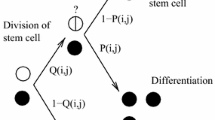Abstract
A dynamic model for cell differentiation, where cells with internal chemical reaction dynamics interact with each other and replicate was studied. It led to spontaneous differentiation of cells and determination, as discussed in the isologous diversification. The following features of the differentiation were obtained: (1) hierarchical differentiation from a ’stem’ cell to other cell types, with the emergence of the interaction-dependent rules for differentiation; (2) global stability of an ensemble of cells consisting of several cell types, that were sustained by the emergent, autonomous control on the rate of differentiation; (3) existence of several cell colonies with different cell-type distributions. The results provide a novel viewpoint on the origin of a complex cell society, while relevance to some biological problems, especially to the hemopoietic system, is also discussed.
Similar content being viewed by others
References
Alberts, B., D. Bray, J. Lewis, M. Raff, K. Roberts and J. D. Watson (1983, 1989, 1994). The Molecular Biology of the Cell, New York: Garland.
Bignone, F. J. (1993). Cells-gene interaction simulation on a coupled map lattice. J. Theor. Biol. 161, 231.
Delbrück, M. Discussion in: Unités Biologiques Douées de Continuité Génétique Editions du CNRS (Lyon) 33.
Eigen, M. and P. Schuster (1979). The Hypercycle: A Principle of Natural Self-Organization, Berlin: Springer-Verlag.
Fankhauser, G. (1955). In Analysis of Development, B. H. Willier et al. (Eds), Philadelphia, PA: Saunders, pp. 126–150.
Goodwin, B. (1963). Temporal Organization in Cells, London: Academic Press.
Goodwin, B. (1982). Development and evolution. J. Theor. Biol. 97, 43.
Hess, B. and A. Boiteux (1971). Oscillatory phenomena in biochemistry. Ann. Rev. Biochem. 40, 237.
Gordon, R., N. K. Bjoklund and P. D. Nieuwkoop (1994). Dialog on embryonic induction and differentiation waves. Int. Rev. Cytol. 150, 373.
Kaneko, K. (1990). Clustering, coding, switching, hierarchical ordering, and control in network of chaotic elements. Physica 41D, 137.
Kaneko, K. (1991). Globally coupled circle maps. Physica 54D, 5.
Kaneko, K. (1992). Mean field fluctuation in network of chaotic elements. Physica 55D, 368.
Kaneko, K. and T. Yomo (1994). Cell division, differentiation, and dynamic clustering. Physica 75D, 89.
Kaneko, K. and T. Yomo (1995). A theory of differentiation with dynamic clustering, in Advances in Artificial Life, F. Moran et al. (Eds), Springer, pp. 329–340.
Kaneko, K. and T. Yomo (1997). Isologous diversification: a theory of cell differentiation. Bull. Math. Biol. 59, 139.
Kauffman, S. A. (1969). Metabolic stability and epigenesis in randomly constructed genetic nets. J. Theor. Biol. 22, 437.
Mjolsness, E., D. H. Sharp and J. Reinitz (1991). A connectionist model of development. J. Theor. Biol. 152, 429.
Nakahata, T., A. J. Gross and M. Ogawa (1982). A stochastic model of self-renewal and commitment to differentiation of the primitive hemopoietic stem cells in culture. J. Cell. Phys. 113, 455.
Newman, S. A. and W. D. Comper (1990). Generic physical mechanisms of morphogenesis and pattern formation. Development 110, 1.
Novick, A. and M. Weiner (1957). Enzyme induction as an all-or-none phenomenon. Proc. Natl. Acad. Sci. USA. 43, 553.
Ogawa, M. (1993). Differentiation and proliferation of hematopoietic stem cell. Blood 81, 2844.
Schofield, R., S. Load, S. Kyffin and C. M. Glibert (1980). Self-maintenance capacity of CFU-S. J. Cell. Phys. 103, 355.
Sonneborn, T. M. (1964). The differentiation of cell. Proc. Natl. Acad. Sci. USA. 51, 915.
Till, J. E., E. A. McCulloch and L. Siminovitch (1964). A stochastic model of stem cell proliferation, based on the growth of spleen colony-forming cell. Proc. Natl. Acad. Sci. USA 51, 29.
Thomas, R., D. Thieffry and M. Kaufman (1995). Dynamical behavior of biological regulation networks. Bull. Math. Biol. 57, 247.
Turing, A. M. (1952). The chemical basis of morphogenesis. Phil. Trans. Roy. Soc. 237, 5.
Tyson, J. J. et al. (1996). Chemical kinetic theory understanding cell-cycle regulation. TIBS 21, 89.
Author information
Authors and Affiliations
Rights and permissions
About this article
Cite this article
Furusawa, C., Kaneko, K. Emergence of rules in cell society: Differentiation, hierarchy, and stability. Bull. Math. Biol. 60, 659–687 (1998). https://doi.org/10.1006/bulm.1997.0034
Received:
Accepted:
Issue Date:
DOI: https://doi.org/10.1006/bulm.1997.0034




